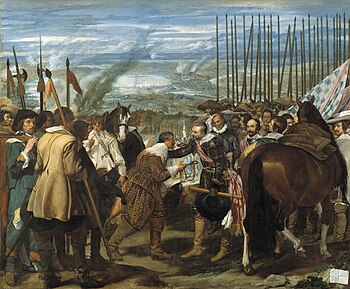The Surrender of Breda
| The Surrender of Breda | |
|---|---|
|
Spanish: La rendición de Breda, Las lanzas |
|
 |
|
| Artist | Diego Velázquez |
| Year | 1634–5 |
| Type | Oil on canvas |
| Dimensions | 307 cm × 367 cm (121 in × 144 in) |
| Location | Museo del Prado, Madrid, Spain |
La rendición de Breda (English: The Surrender of Breda, also known as El cuadro de las lanzas or Las lanzas) is a painting by the Spanish Golden Age painter Diego Velázquez. It was completed during the years 1634–35, inspired by Velázquez's visit to Italy with Ambrogio Spinola, the Genoese general who conquered Breda on June 5, 1625. It is considered one of Velázquez's best works. Jan Morris has called it "one of the most Spanish of all pictures".
The capture of Breda in 1625 was one of the few major successes of Spanish arms in the latter stages of the Eighty Years' War. The Spanish general, Genoese aristocrat Ambrogio Spinola, conquered Breda against the instructions of his superiors. Before its capture, the Spanish government had decided that siege warfare against heavily defended towns of the Low Countries was too wasteful and that they would concentrate instead on an economic blockade of the Dutch republic. The bulk of Spanish forces were diverted to the unfolding Thirty Years War.
Breda, a city near the frontier of Holland proper had been occupied in 1567 by the Duke of Alba, ten years afterwards recovered by Holach, and again seized by Haultepenne. The town was the seat of the Orange family, who had a castle there.
In 1624, the suspension of hostilities in Germany enabled the Spanish to concentrate their forces towards Breda. Although attacking such a formidable fortress was widely considered to be unwise, Ambrogio Spinola made the bewildering executive decision to march on Breda, accompanied by the Marquis de Leganés and Carlos Coloma. Spinola had made a military reputation for himself in 1604 and been rewarded with the Golden Fleece for conquering Ostend in Flanders. Consequently, the siege of Breda was not only a clash between the Netherlands and Spain, but a “decisive contest between two famous generals, [Spinola and Dutch general Nassau], both well versed in the arts of fortification, who had their renown at stake”.
...
Wikipedia
